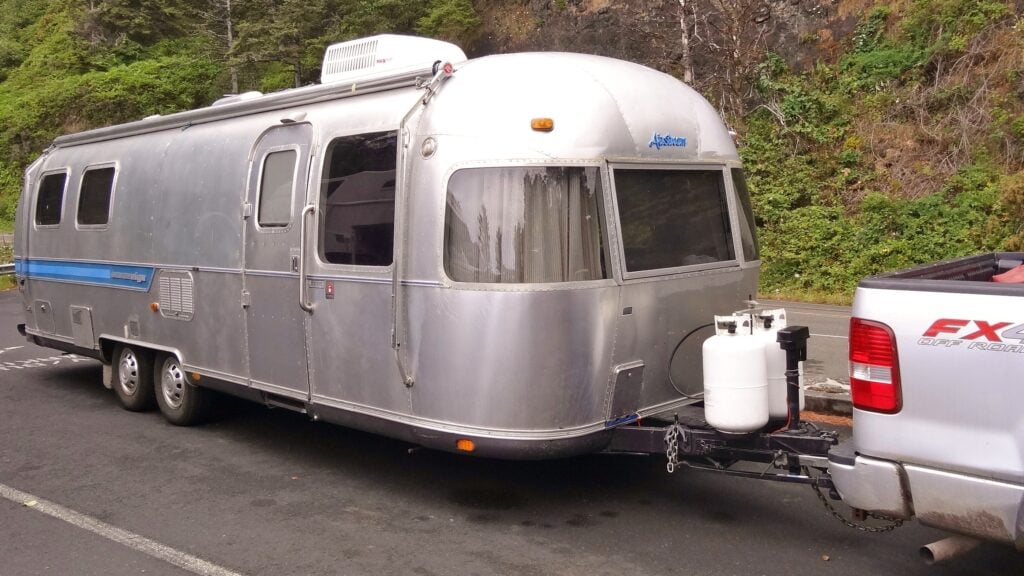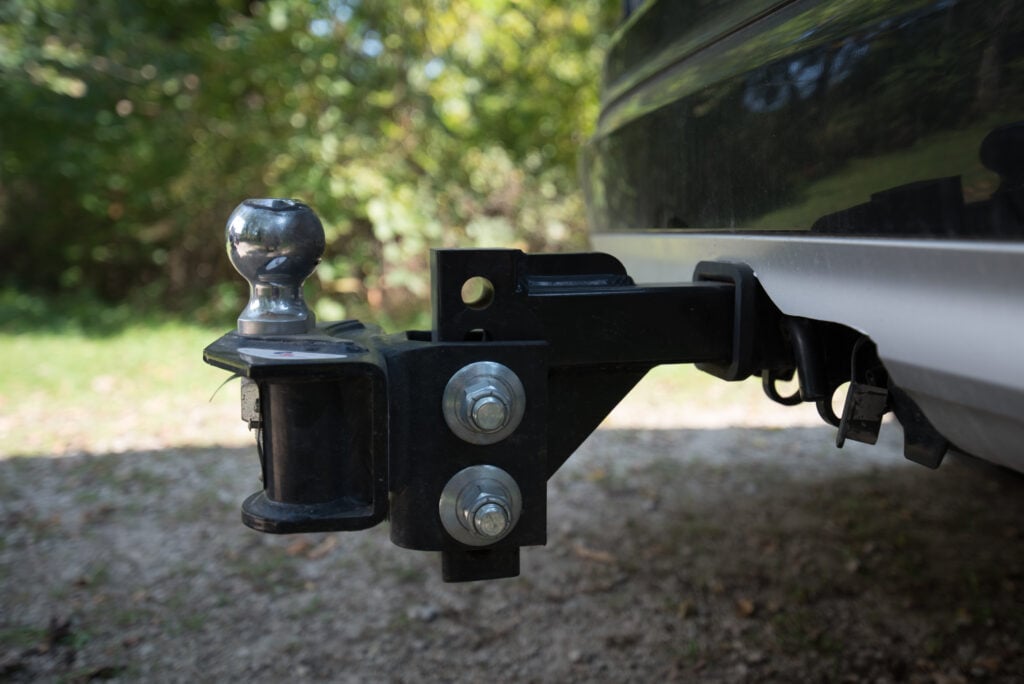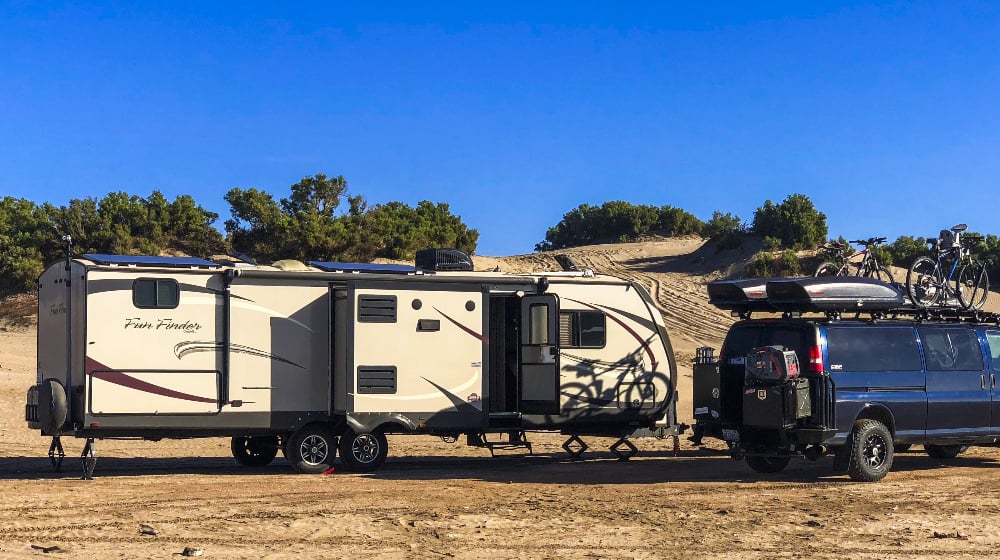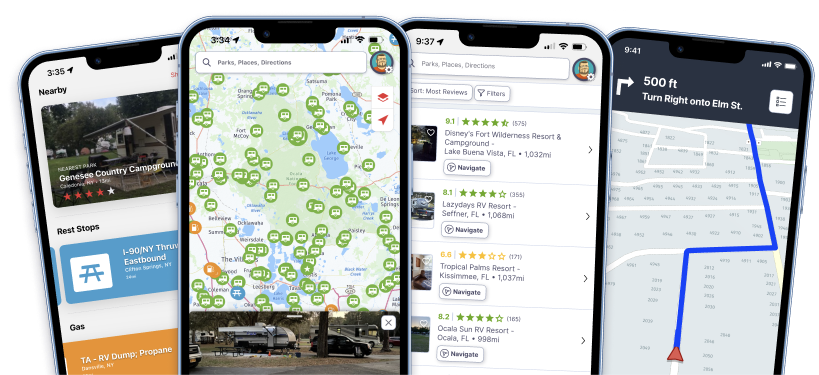
Better RVing Begins with Understanding Gross Vehicle Weight
The gross vehicle weight of your RV matters. How much? In some cases, it is a matter of life or death. But it’s not all that complicated when you take a few minutes to consider all the variables. Start by breaking down the important components of the gross vehicle weight formula.
There are dozens of resources on the internet that go into great depth about this subject. Some have formulas you can use for your own calculations. There are even formulas used by dealers to help you determine which RVs in their inventory your particular towing vehicle can safely tow.
There’s no point in rewriting what has already been covered in such detail. This article examines a few real-life RVers’ practical applications of the vehicle weight issue. Learn how this RV gross vehicle weight applies to your RV, your tow vehicle, your toad, and your particular camping lifestyle.
What is RV gross vehicle weight?
Before we look at unique examples of gross vehicle weight, you need to understand that there are basically two main considerations.
The first is that every RV has a specific gross vehicle weight rating (GVWR) that it can safely manage over the long haul. That weight is comprised of the actual manufactured weight of the vehicle. It also includes (and this is where it becomes an issue of lifestyle choices) all the rest of the weight that you add to your RV.
That added weight is usually referred to as the cargo carrying capacity (CCC). In RVs manufactured before 2000, that added weight was referred to as net carrying capacity (NCC). Either way, it refers to everything extra you add to your RV.
What RV cargo are you carrying?
The cargo-carrying capacity includes the weight of all fluids such as gas, propane, water, and the content of your holding tanks. It also includes you and your furry friends. And also, all your food, gear, supplies, tools, clothes, and extra stuff stored in your basements.
These extras can add up quickly and with some RVs, the cargo capacity may be very limited, so you need to pay close attention to all the extras you put into your RV, like your tarps and tents, easy-ups, barbecue, fishing, hunting, hiking, and boating gear, and in our case, dog food.
We travel with 4 dogs weighing between 30 and 40 pounds. Their combined weight is equal to another human being. The real concern is the weight of their dog food. They consume 10 pounds of dehydrated dog food every week. This particular food is difficult to find in most of the places where we travel. We often have over 200 pounds of dog food in our RV. That weight all needs to be accounted for in our total allowable cargo carrying capacity.
For your reference, a gallon of milk, or propane, or gasoline, or water, weights about 8 pounds. If your RV has a 50-gallon water tank, a 20-gallon propane tank, and your gas tank hold 70 gallons of gasoline, those full tanks add up to 1,120 pounds of weight that also needs to be accounted for in your total carrying capacity calculation.

A weight distribution and sway control trailer hitch and ball for RVs and trailer towing. Photo via Wikipedia Creative Commons
Tony Webster from Minneapolis, Minnesota, United States, CC BY 2.0, via Wikimedia Commons
How tongue, hitch and pin weight impacts your RV
Additionally, you need to consider how towing impacts gross vehicle weight. When you are towing your RV or towing a vehicle behind your RV, both vehicles have maximum weight limits and they directly affect each other when the two vehicles are connected to each other.
Your RV weight limit may be fine, but you could exceed the weight limits of your towing vehicle. The result create unsafe driving conditions. For example, if you’re towing a 40-foot fifth wheel toy hauler behind a diesel pick-up truck, some of the weight of the fifth wheel is transferred through the pin weight to the truck, and depending on what the gross vehicle weight of the trailer is, and how that weight is distributed, it could put extra strain on the truck and make it unsafe to drive.
Additionally, if you’re towing a travel trailer behind an SUV, some of the weight of the trailer is transferred through the tongue or hitch and adds to the gross vehicle weight of the SUV. And in that same vein, if you’re towing a toad behind a motorhome, the weight of the towed vehicle is transferred to the motorhome through the hitch weight.
What about towing motorcycles behind RVs?
If the toad is on a dolly, some of the weight of the dolly and the toad are both transferred to the motorhome through the hitch and must be included in the overall cargo carrying capacity for the motorhome. Want to add a motorcycle rack to the back of your RV? The weight of the rack and motorcycle must be included too.
A fully dressed Harley can weigh more than 1000 pounds. The motorcycle rack could add several hundred pounds of extra weight. Together, they can lower the amount of available carrying capacity you have in your RV.
These are all lifestyle choices. If you want to mount your Harley on a motorcycle rack, you may not have much carrying capacity leftover for other gear. It might be a trade-off you’re willing to make. Or, you might need to shop for an RV that allows for more carrying capacity.
Calculating RV weight distribution
The weight distribution needs to be part of your carrying capacity calculation. I mentioned above that the way the 40-foot toy hauler was loaded could impact the pin weight of the pick-up truck’s total weight.
If you put all the extra weight in the back of the toy hauler behind the trailer’s wheels, it tends to lift the front end of the trailer. This lowers the pin weight. To some extent, this can be good. But lifting too much weight can cause RV trailer sway. Using this method to control the pin weight is not a safe option.
Both vehicles need to be within their allowable gross vehicle weight limits and properly balanced to each other. You may need to take a trip to a scale and unhook your trailer to accurately measure the weight of both vehicles separately and then in combination.

Towing and towed RV combinations are endless.
Be sure to consider your RV’s towing limitations, so you chose the right fit for your lifestyle. Plan to carry a lot of extra gear in or attached to your RV? You may need to spend more on your towing vehicle. We have friends who tow a 45-foot fifth wheel. They have a commercial diesel truck modified for RV towing.
Another couple we know intentionally purchased a large Class A diesel motorhome. Their lifestyle involves traveling around the country competing in car races. They tow a heavy trailer in which they keep the race car, parts, tools, and other gear. They don’t want to drive a stock car around town. So they built a platform in the trailer for a second vehicle.
Consequently, they tow a huge trailer behind their motorhome with two cars stacked in the trailer. The total weight distribution of the trailer must be managed carefully. Even with a large diesel motorhome as the towing vehicle, excessive weight is dangerous.
Don’t overload an RV then try to compensate with distribution
All vehicle manufacturers assume theirnvehicle will have an even weight distribution from side to side and from front to back. But that may not always be the case. The axles each have a maximum weight limit. Again that is based on the assumption of an even weight distribution from one wheel to the other.
If your RV has 3 large slides on one side and one on the other side, there may be an inherent weight mismatch in the way the rig is set up. Then you might unwittingly compound that problem with the way you distribute your gear in the RV.
If you think your rig is not well balanced from side to side, you may need to drive your rig over the scales. Measure one wheel at a time or have your rig’s weight evaluated by professionals.
Learn more about RV towing safety
Understanding all these issues can help you decide if you will need a half-ton truck or a one-ton truck to haul your RV. The gross weight of your rig is the actual manufacturer’s weight plus you, all your gear, and its attachment to another vehicle. You need to understand what your rig’s weight limits are, how much weight capacity you have for all the extras, and if your lifestyle fits within those limits, because operating your RV outside of those parameters is not safe or prudent.
Enjoy your RV and drive safely. For more information, check out the following short video by Michael Hall explaining RV weight issues:
Resources and Where to Weigh Your RV
Escapees RV Membership program makes SmartWeigh services available to their club members. For a small fee, you can make an appointment at one of their scales to have your towing (or towed) vehicle, as well as, your RV evaluated for total weight, distribution, and safety
Also check out these great resources for more information:
- RV Towing: Important Things To Consider
- This Trailer Tongue Weight Scale Could Save Your Life
- Watch This Out-Of-Control Trailer Flip And Crash On The Highway
- How To Avoid The Dangers Of An Overweight Trailer

1 gallon of propane weighs 4.4 pounds, not 8 pounds mentioned in the article.
“For your reference, a gallon of milk, or propane, or gasoline, or water, weights about 8 pounds.”
It’s good to explain the density of liquids, but no – all liquids are not the same density. Anything that’s almost all water (including milk or wastewater) weighs the same roughly 8 pounds per US gallon, but gasoline is about 6 pounds per US gallon, and propane is only 4.1 pounds per US gallon.
“… if you’re towing a toad behind a motorhome, the weight of the towed vehicle is transferred to the motorhome through the hitch weight.”
Not if the toad is on its own wheels – then the tow bar doesn’t carry any of the toad’s weight, so it adds nothing (other than half the tow bar’s weight) to the motorhome’s gross weight.
Greetings all
This is an awesome article, but is there a way to break down this article into vehicles that tow a fifth wheel, class A motorhome (with and without a tag axle), Class B motorhome, and Class C motorhome?
I am really disappointed in Peggy Dent and RVLife editors. She begins with the “fact” that milk, gas (and diesel), propane and water all weigh 8 pounds. I cannot read further because if these “facts” are incorrect, what else is wrong in the article. A two minute check will reveal that a gallon of milk weights 8.6 pounds, a gallon of water is 8.4 pounds, a gallon of diesel weights 7 pounds, gasoline weighs 6 pounds and, the complete misrepresentation — propane weighs 4.2 pounds (one half the weight of water). Please, Peggy and editor, do your job before you mislead your readers.
A propane tank is measured in LBs not gallons. A 20# tank holds 4.7 gallons weighing 4.2lbs each. A 20# tank holds 20 lbs and weighs 37 lbs full. (17lbs for the tank empty). Gasoline weighs 6lbs per gallon. Diesel 7lbs. I read an article about a guy who weighed EVERYTHING he put into or took out of his RV. Weighed groceries when returning from the store, garbage going out. A little excessive but then it doesn’t take long for it to add up to more than you should carry.
I want information on towing.
Peggy thanks for providing these articles on safety. If it helps one RV owner better understand the safe operation and limits of their rig it makes the roads safer for everyone. Unfortunately I see little in the way of enforcement regarding RVs and even less knowledge of many new owners.
Many Travel Trailer manufacturers (KZ for example) include passengers in their GVWR, even while the vehicle is parked for overnight camping. Therefore if you have a cargo capacity of 1000 pounds, it may seem a lot, however if you are sleeping 4 persons, have propane, battries and gear in the Trailer, you will be overweight (over the GVWR) every stop when the occupants enter the Trailer.
Can you exceed the GVWR when your travel trailer is parked and stabilized? Is the gvwr only applied when the trailer is on the road.
GVWR is a limit and applies the load on a moving vehicle. It is relevant to a stationary vehicle to the extent that at some point, the vehicle will likely move with whatever load is connected/applied. Relative to a trailer, GVWR needs to account for the tongue weight the trailer applies. GVWR is a reflection of what the vehicle was designed to carry (not pull) that factors in tire capacity, wheel capacity, axle capacity, and suspension capacity. While you can’t actually change the GVWR of record, because that is set by the way the manufacturer sold the vehicle, you can improve your vehicle’s ability to carry weight by improving the weakest link in those 4 items. What is not addressed in the article is the GCWR or the gross combined weight rating of the vehicle and tow together. GCWR addresses the ability of the vehicle to steer and brake a towed load.